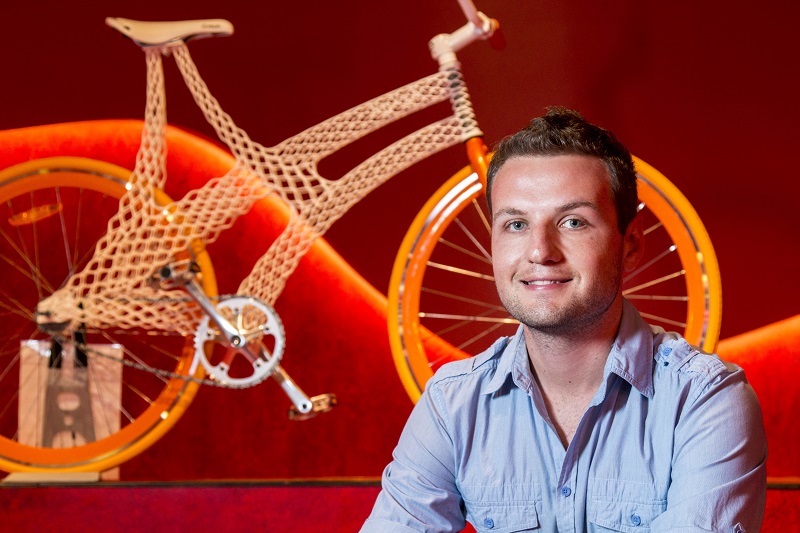What does an Industrial Designer do?
Industrial Designers (sometimes called Product Designers) create the future – sounds pretty vague and broad, but it’s true! Almost everything around you has been designed by an Industrial Designer, from the phone/tablet/computer you are reading this on to the furniture you are sitting on or the car/bicycle/train you travel on today. It’s an extremely broad career path, and is ultimately about solving problems through design.
What do you work in and what is your specialty?
I wear many different hats at the moment, but I like keeping busy! Firstly I am a PhD Researcher at Griffith University, where I am developing smart products embedded with technology to improve athletes and those with health problems. My work often includes 3D printing since this is one of my real passions, and you’ll often find me hanging out in our brand new 3D printing lab on the Gold Coast. This leads on to the second hat that I wear, which is as a lecturer at Griffith University, teaching into the Industrial Design and Design courses, particularly some of the more technology and 3D printing focused courses. This means that I get to share the latest tools, techniques and trends directly with the students, and also keeps me on my toes as I never know what crazy design ideas I’m going to see next. As well as these roles I am a regular guest writer for a number of international 3D printing companies and an ambassador for Advance Queensland.
How did you become interested in this area and when did you first start?
To many people 3D printing is a very new concept, however I did my first 3D print in 2009 while studying a Bachelor’s degree in Product Design at Griffith, at that time there was only one 3D printer in the entire university, and it seemed like a very mysterious and magical process. Who knew you could print something in three-dimensions? But from that point 3D printing became the most amazing tool to turn the 3D digital files I created on the computer screen into physical objects I could hold in my hands, in a relatively quick time-frame. However it was not until 2014 that I was invited to come back to Griffith to do some teaching, and was shocked to now see an entire room full of 3D printers, I instantly quit my job and decided to not only come and teach at the university, but enrol as an Honours student to make 3D printing my specialty. Very risky, but I just knew 3D printing was going to be big.
What study path have you taken to get here?
You could say that my path to this point has been the “scenic route”, through high school I was convinced I wanted to be an Architect, and indeed I completed my Bachelor’s degree in Architecture immediately following high school at the University of Newcastle. I then spent a year working in an Architect firm, before deciding that buildings take too long to design and construct, and I wanted to focus on smaller products that would happen much faster. So back to university I went, this time in Brisbane at Griffith University studying Product Design. I gained an internship in a local design consultancy at the end of my second year, and this turned into my full-time job upon graduating, where I spent a few years working on some quite high profile products including the safety harness system for the Q1 SkyPoint climb and the latest MagnaLatch ML3 pool gate latch. As mentioned before, in 2014 I came back to university AGAIN to complete a 1 year Honours program, which led me into the PhD. So if nothing else, I hope this shows that you don’t need to get it right straight out from school, if you do the maths I’m about to start my 10th year as a full time uni student!
What do you like most about your job?
There are many things I love about my job, but I’ll keep it to just 2 main things: Firstly, I have access to some of the most cutting-edge equipment and technology that you would just never find anywhere else, which is exactly what motivated me to come and continue studying. I get to play with toys before most people even hear of them, for example in 2017 we have a 3D printer that can produce metal parts arriving. Yes, 3D printing in metals like titanium or steel! The second thing is the people, both the students I teach and the researchers I work with from many other disciplines who are doing amazing things that I often barely understand. Every day I am inspired by the creativity around me and reminded that tomorrow is an exciting place.
Do you have any particular career highlights?
What advice would you give to someone interested in working in this area?
Don’t listen to your parents! Ha ha I know that might seem like bad advice, but bare with me. The world is rapidly changing thanks to technology, and chances are you’ve probably already heard statistics like “40% of jobs will be taken over by machines by 2030.” This means that many of the jobs your parents might be familiar with and encourage you to do won’t even exist by the time you graduate. If you look at my story, I bet no one thought 3D printing was a career, but it is. So my best advice is to stay flexible, you don’t necessarily need to know what you want to be when you grow up (I still haven’t grown up), and pursue what you enjoy. I know that might all be a little cliched, but seriously it’s worked for me.

Name
James Novak
Career
Industrial Designer
Current Role
PhD Researcher
Griffith University
